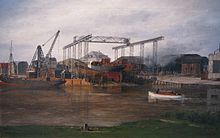Schichau Unterweser
The Bremerhaven shipyard Schichau Unterweser AG (SUAG) was established in April 1945 as F. Schichau Aktiengesellschaft as a refugee company by Hermann Noë in Bremerhaven . After a difficult new beginning, the company developed into a leading specialist shipyard in the field of tractor construction. Due to the shipyard crisis , F. Schichau merged in 1972 and 1988 and was finally found, after several bankruptcies, as "S" in the name of the successor company SSW Schichau Seebeck Shipyard GmbH .
Company history
Post-war period (1945–1949)
Hermann Noë was previously the general director of the Schichau-Werke with around 43,000 employees in Elbing , Danzig and Königsberg . The Noë family managed to escape from Danzig in March 1945 with a torpedo boat lying in the shipyard for repairs. At the beginning of 1945 some unfinished submarine and torpedo boat hulls were towed to Bremerhaven, but further construction in the last months of the war was no longer carried out. With the former employees of the lost shipyards in the east, operations in Bremerhaven at the Neuer Hafen were set up on the former site of the salvage company W. Schuchmann under difficult conditions. Initially, around 300 employees mainly carried out steel work and repairs on machines and agricultural machinery. Fish wagons for the fishing port were built, locomotives and trams repaired, photoelectrically controlled flame cutting machines were developed, designed, built and sold under the name “Schichau Monopol”.
After the Allies approved shipbuilding, small ships were built, mainly for fishing. Since there were no slipways or slipways available, the ships were lowered into the water using the floating crane (stacking lift). Only later was a provisional transverse helm built.
Floating dock from Gdansk
The floating dock (100 meters long, 28 meters wide, 3,000 t load capacity), which was transferred from Danzig to Lübeck in good time before the end of the war , was owned by the Lübeck Flender Works and was awarded to England under TNC number 57. The federal government bought it back from England with other floating docks and after long and difficult negotiations it was returned to F. Schichau AG in 1953. It was located in Bremerhaven's Kaiserhafen III at the southern end of the Bananenkaje and was used in particular for ship repairs, but was also used by other Bremerhaven shipyards for ship extensions. In 1968 the dock was lengthened by 24 meters and received a crane. The extension was made at the Seebeck shipyard. The dock and the extension were put together in a dry dock of the technical operations of Norddeutscher Lloyd and since then can lift 4,000 t.
Tractor construction (1969)
F. Schichau AG could not build on the history and great successes of its predecessor "Schichau Werke", which expanded into a huge company from 1837 to 1945 through sophisticated products, good business policy, growth and also through the purchase of other companies. On the other hand, at the beginning of the 1960s it was considered the leading specialist shipyard for tractor construction.
The world's most powerful salvage tugs such as the Pacific (1962–2001), Oceanic (delivery 1969) and Arctic (delivery 1969) were built here and used as ocean-going and salvage tugs. They had a drive power of 10,000 HP, which was later increased to 13,000 HP by installing new drive systems. They were mainly used as salvage tugs by the Bugsier Reederei Hamburg (Schuchmann). The Arctic was converted into a yacht in 1994 and has been called the Arctic P since then .
Fusion (1972)
The shipyard crisis in the early 1970s led to great difficulties for many shipyards, with some shipyards having to close, others merging. Schiffbau-Gesellschaft Unterweser GmbH, also based in Bremerhaven , founded in 1903 as Schiffswerft Delphin Riedemann & Co and renamed Schiffbau-Gesellschaft Unterweser GmbH in 1910, had focused on the construction of fishing vessels , ferries and special ships . F. Schichau AG merged with this shipyard in 1972 and was called Schichau Unterweser AG, or SUAG for short. From then on, mainly ferry ships (e.g. Pride of Calais ), oil rig suppliers , dredgers and other special ships were built.
Incorporation into the Vulkan Verbund and merger with Seebeck (1984)
The merger efforts in German shipbuilding continued and the SUAG was incorporated into the Vulkan-Verbund in 1984 and merged there with the Seebeckwerft AG to form Schichau-Seebeckwerft AG in 1988 .
Well-known ships of the shipyard (selection)
- Corinna Drescher , container ship from 1978
- Arctic , mega yacht from 1969
- Oceanic , salvage tug from 1969
- Pacific , ocean tug from 1962
- Herald of Free Enterprise , Ro-Ro ferry from 1980
- European Gateway , RoRo cargo and ferry from 1975
- Helgoland and Fehmarn of the Helgoland class , salvage tug from 1966
- Wangerooge , Spiekeroog , Langeoog , Baltrum Norderney and Juist of the Wangerooge class , sea tugs of the German Navy from 1968 to 1971
- Victor Hensen , research ship from 1975
Literature and Sources
- P. Kuckuck: Unterweserwerften in the post-war period. Edition Temmen . Bremen 1998, ISBN 3-86108-612-3 .
- Behrend Oldenburg: SSW ferry and special shipbuilding. 125 years of shipbuilding tradition. 125 years of tradition in shipbuilding. Bremerhaven 2001.
- C. Boie: Shipbuilding in Germany 1945–52. Verlag Gert Uwe Detlefsen, Bad Segeberg 1993, ISBN 3-928473-11-5 .
Web links
- Information about the shipyard ( Memento from July 19, 2011 in the Internet Archive )





